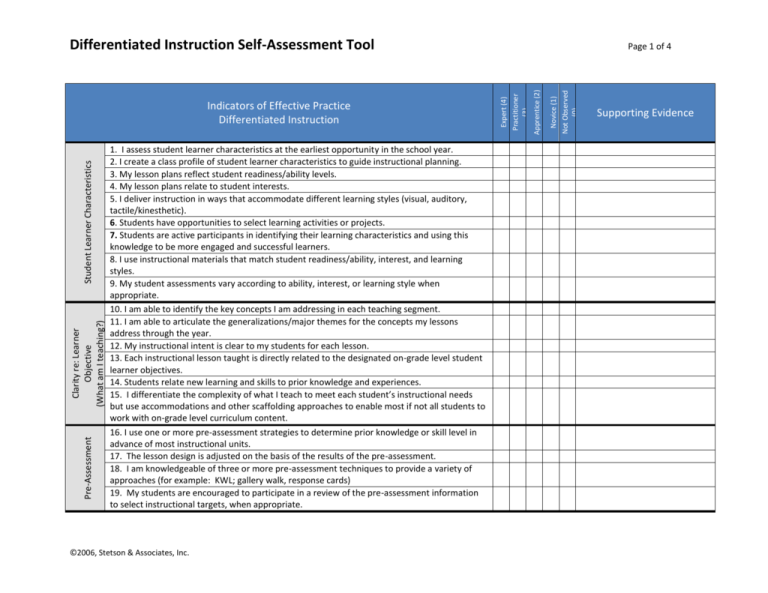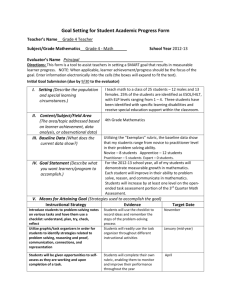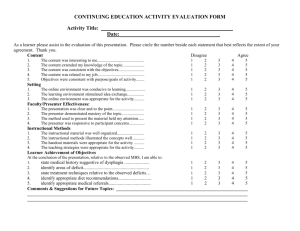Differentiated Instruction Self
advertisement

Differentiated Instruction Self-Assessment Tool Pre-Assessment Clarity re: Learner Objective (What am I teaching?) Student Learner Characteristics 1. I assess student learner characteristics at the earliest opportunity in the school year. 2. I create a class profile of student learner characteristics to guide instructional planning. 3. My lesson plans reflect student readiness/ability levels. 4. My lesson plans relate to student interests. 5. I deliver instruction in ways that accommodate different learning styles (visual, auditory, tactile/kinesthetic). 6. Students have opportunities to select learning activities or projects. 7. Students are active participants in identifying their learning characteristics and using this knowledge to be more engaged and successful learners. 8. I use instructional materials that match student readiness/ability, interest, and learning styles. 9. My student assessments vary according to ability, interest, or learning style when appropriate. 10. I am able to identify the key concepts I am addressing in each teaching segment. 11. I am able to articulate the generalizations/major themes for the concepts my lessons address through the year. 12. My instructional intent is clear to my students for each lesson. 13. Each instructional lesson taught is directly related to the designated on-grade level student learner objectives. 14. Students relate new learning and skills to prior knowledge and experiences. 15. I differentiate the complexity of what I teach to meet each student’s instructional needs but use accommodations and other scaffolding approaches to enable most if not all students to work with on-grade level curriculum content. 16. I use one or more pre-assessment strategies to determine prior knowledge or skill level in advance of most instructional units. 17. The lesson design is adjusted on the basis of the results of the pre-assessment. 18. I am knowledgeable of three or more pre-assessment techniques to provide a variety of approaches (for example: KWL; gallery walk, response cards) 19. My students are encouraged to participate in a review of the pre-assessment information to select instructional targets, when appropriate. ©2006, Stetson & Associates, Inc. Novice (1) Not Observed (0) Expert (4) Practitioner (3) Apprentice (2) Indicators of Effective Practice Differentiated Instruction Page 1 of 4 Supporting Evidence Differentiated Instruction Self-Assessment Tool Flexible Grouping Individual Student Supports Effective Instructional Strategies 20. I do not use lecture as my predominant instructional delivery method. 21. My repertoire of instructional strategies consists of enough variation that I am able to select the best match for the content, maintain student interest, and add richness to the teaching learning experience. 22. I use a variety of instructional strategies are used to differentiate content, (concept definition, tiered learning, and curriculum compacting). 23. I use a variety of instructional strategies are used to differentiate process, (assisted notetaking, differentiated lecture, graphic organizers, jigsaw, gallery walk, etc.). 24. I use a variety of instructional strategies are used to differentiate assessment, (portfolios, response cards, rubrics, project-based learning, etc.). 25. I design instructional accommodations for any student who requires them (not just for students receiving special education services). 26. I modify curricular goals for students whose IEP specifies modified content. 27. I use the Instructional Design Tool or something similar to guide planning for differentiated lessons. 28. I do not use individual student supports if the instructional lesson can be adjusted to meet the needs of every student. 29. Supports are available for students who are struggling with the content. 30. Support are available for students who need additional challenges/opportunities to extend learning. 31. I appropriate incorporate instructional accommodations, curricular modifications, differentiated assessment, and personal supports into the lesson delivery as stipulated on a student’s IEP. 32. I do not make decisions about which students will need individual support until I design the lesson. 33. My flexible grouping arrangements are based on knowledge of student: readiness/ability, interest, learning style, choice. 34. Student learning groups and the basis for their selection change periodically. 35. Assessment of work completed during group time is based on group work and individual student assignments as appropriate. 36. I explicitly teach appropriate behaviors for group work including group norms, team member roles and responsibilities, and noise level considerations. ©2006, Stetson & Associates, Inc. Not Observed (0) Novice (1) Expert (4) Practitioner (3) Apprentice (2) Indicators of Effective Practice Differentiated Instruction Page 2 of 4 Supporting Evidence Differentiated Instruction Self-Assessment Tool Learning Environment 37. Teacher works collaboratively with students to develop norms for individual behavior and for team behavior. 38. Classroom arrangement is conducive to student collaboration and differentiated instruction, (clusters of desks, centers, work stations, etc.). 39. Strategies are in place to minimize downtime during transitions, (“sponge activities, enrichment, etc.). 40. Student work and products are displayed around the classroom. 41. Student talk, movement, and activities are related to instruction. 42. Students are taught process or study skills appropriate for level. 43. Instruction is student-directed an appropriate proportion of the school day or week. 44. I ensure that I have a high percentage of academic learning time (ALT) in my classrooms by minimizing non-instructional tasks and classroom interruptions. ©2006, Stetson & Associates, Inc. Novice (1) Not Observed (0) Expert (4) Practitioner (3) Apprentice (2) Indicators of Effective Practice Differentiated Instruction Page 3 of 4 Supporting Evidence Differentiated Instruction Self-Assessment Tool Page 4 of 4 Teacher Profile of Effective Practices Related to Differentiated Instruction Total Score in Each Area Expert Practitioner Apprentice Novice Not Observed Student Learning Characteristics (used to direct differentiated instruction decisions) Clarity re: Learner Objective (taught within context of district on-grade level objectives) Pre-Assessment Strategies (determines prior knowledge and readiness for intended lesson) Effective Instructional Strategies (research-based, varied, and applied appropriately) Flexible Grouping Strategies (based on a variety of criteria, changed and monitored often) Individual Student Supports (provision of additional support to individual students when needed) Learning Environment (classrooms conducive to learning and appropriate behaviors) Component: Student Learner Characteristics (Indicators 1-9) Total of: 30-36 = Expert Total of: 19-29 = Practitioner Total of: 11-18 = Apprentice Total of: 1-10 = Novice Component: Individual Student Supports (Indicators 28-32) Total of: 16-20 = Expert Total of: 11-15 = Practitioner Total of: 6-10 = Apprentice Total of: 1-5 = Novice Component: Clarity re: Learner Objective (Indicators 10-15) Total of: 20-24 = Expert Total of: 13-19 = Practitioner Total of: 7-12 = Apprentice Total of: 1-6 = Novice Component: Flexible Grouping (Indicators 33-36) Total of: 13-16 = Expert Total of: 9-12 = Practitioner Total of: 5-8 = Apprentice Total of: 1-4 = Novice Component: Pre-Assessment Strategies (Indicators 16-19) Total of: 13-16 = Expert Total of: 9-12 = Practitioner Total of: 5-8 = Apprentice Total of: 1-4 = Novice Component: Learning Environment (Indicators 37-44) Total of: 25-32 = Expert Total of: 17-24 = Practitioner Total of: 9-16 = Apprentice Total of: 1-8 = Novice Component: Effective Instructional Strategies (Indicators 20-27) Total of: 25-32 = Expert Total of: 17-24 = Practitioner Total of: 9-16 = Apprentice Total of: 1-8 = Novice ©2006, Stetson & Associates, Inc. TOTAL





